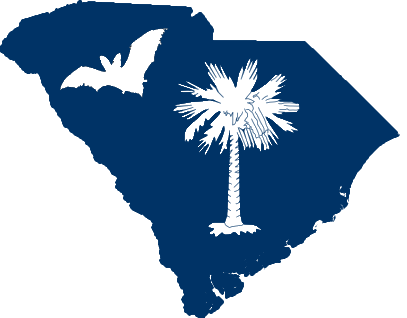White Nose Syndrome Information
White-nose syndrome (WNS) is a fungal disease that causes hibernating bats to wake and burn their energy reserves when insect prey is unavailable, causing them to starve to death. In North America, WNS has killed millions of bats, and at some sites 90 to 100 percent have died. Several species are affected, with the hardest-hit being the Northern long-eared bat, little brown bat, and tri-colored bat. Other species, like the Virginia big-eared bat, have been found with the fungus, but they don’t show signs of being sick with WNS. To learn more about WNS and view the map of the spread of the disease, see https://www.whitenosesyndrome.org/.
To learn more about WNS and its spread in in SC, please see https://www.dnr.sc.gov/wildlife/bats/batswns.html.
Teachers and Parents
Bat World Sanctuary’s- Teacher’s page
Scholatic’s-Into the Bat Cave: 7 Science Activities
One of my kid’s favorite childhood books- Stellaluna
Kidsoup’s- BATS PRESCHOOL ACTIVITIES, CRAFTS, AND LESSONS
Interpreters
Here is a comprehensive field identification key for U.S. Bats:
Field Identification Key and Guide for Bats of the United States of America
Clint N. Morgan, Loren K. Amm erman, Krysta D. Demere, Jeffrey B. Doty, Yoshinori J. Nakazawa, and Matthew R. Mauldin: Bats are the second most speciose lineage of mammals with more than 1,300 recognized species. Overall, bats are extremely ecologically and morphologically diverse, making them of interest …
Field Identification Key and Guide for Bats of the United States of America
What good are bats to SC:
What I have learned about SC bats
White Nose Syndrome:
White Nose Syndrome Range
Bats and White Nose Syndrome (WNS) in SC
Specifics about SC bats:
South Carolina Bat Conservation Plan
The distribution of the bats of South Carolina
South Carolina Colonial Cavity Roosting Bats
South Carolina Foliage Roosting Bats
Large Cavity Bats
- Tri-colored Bat [formerly Eastern Pipistrelle] (Perimyotis subflavus
- Rafinesque’s Big-eared Bat (Corynorhinus rafinesquii)
Crevice Bats
- Big Brown Bat (Eptesicus fuscus)
- Brazilian free-tailed bat (Tadarida brasiliensis)
- LeConte’s free-tailed bat (Tadarida brasiliensis cynocephala) ssp
- Evening Bat (Nycticeius humeralis)
- Eastern Small-footed Myotis (Myotis leibii)
- Little Brown Bat (Myotis lucifugus)
- Northern Long-eared Bat (Myotis septentrionalis)
- Southeastern Bat (Myotis austroriparius)
- Silver-haired Bat in SC
- Silver-haired Bat (Lasionycteris noctivagans)
- Northern Long-Eared Bat (Myotis septentrionalis) Endangered
- Northern Long-Eared Bat (Myotis septentrionalis)
Bats in Bridges and Transportation Structures
South Carolina Foliage Roosting Bats
- Hoary Bat (Lasiurus cinereus)
- Northern Yellow Bat (Lasiurus intermedius)
- Eastern Red Bat (Lasiurus borealis)
- Seminole Bat (Lasiurus seminolus)
Regional Bats of Concern
- Gray bat (Myotis grisescens) Endangered
- Gray bat (Myotis grisescens)
- Indiana bat (Myotis sodalis) Endangered
- Indiana bat (Myotis sodalis)
Small Mammals of Conservation Concern in SC:
SC Shrews
Masked Shrew (Sorex cinereus)
Pygmy Shrew (Sorex hoyi)
SC Moles
Hairy-tailed Mole (Parascalops breweri)
Star-nosed Mole (Condylura cristata)
Meadow Vole
Eastern Woodrat
Southern Fox Squirrel
Mink
Swamp Rabbit
Woodland Jumping Mouse
Eastern Spotted Skunk
Citizen Science
Want to start a local or public bat emergence count? Let us know, maybe we can help get you started. It may be useful to know Pre-Volant / Post-Volant numbers of bats who leave a bat house or known roost. This is especially true if it is a SC colonial species of high concern.
Colonial Crevice Roosting Bats of High Concern (Will Roost in Bat houses or places with narrow slots and of conservation concern in SC)
- Big Brown Bat (Eptesicus fuscus)
- Eastern Small-footed Myotis (Myotis leibii)
- Little Brown Bat (Myotis lucifugus)
- Northern Long-eared Bat (Myotis septentrionalis)
- Southeastern Bat (Myotis austroriparius)
- Silver-haired Bat (Lasionycteris noctivagans) * Sometimes lumped with Non_Colonial bat species
Colonial Cavity Roosting Bats of High Concern (Will Roost in large open man made structures like a mine, barn, Silo or abandoned house and of conservation concern in SC)
- Rafinesque’s Big-eared Bat (Corynorhinus rafinesquii)
- Tri-colored Bat (formerly Eastern Pipistrelle) (Perimyotis subflavus)
Non-Colonial Bats of High Concern (Will Roost Singly or in small numbers usually in foliage, Pine Straw mats or Spanish Moss high in trees and therefore too hard to count in roosts but of conservation concern in SC)
- Hoary Bat (Lasiurus cinereus)
- Northern Yellow Bat (Lasiurus intermedius)
- Red bat (Lasiurus borealis)
- Seminole Bat (Lasiurus seminolus)
